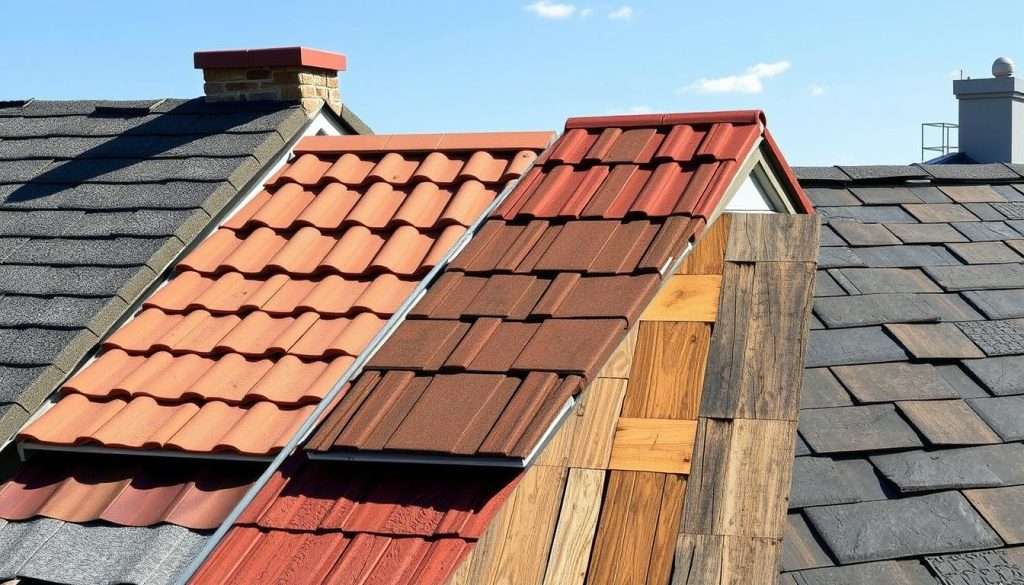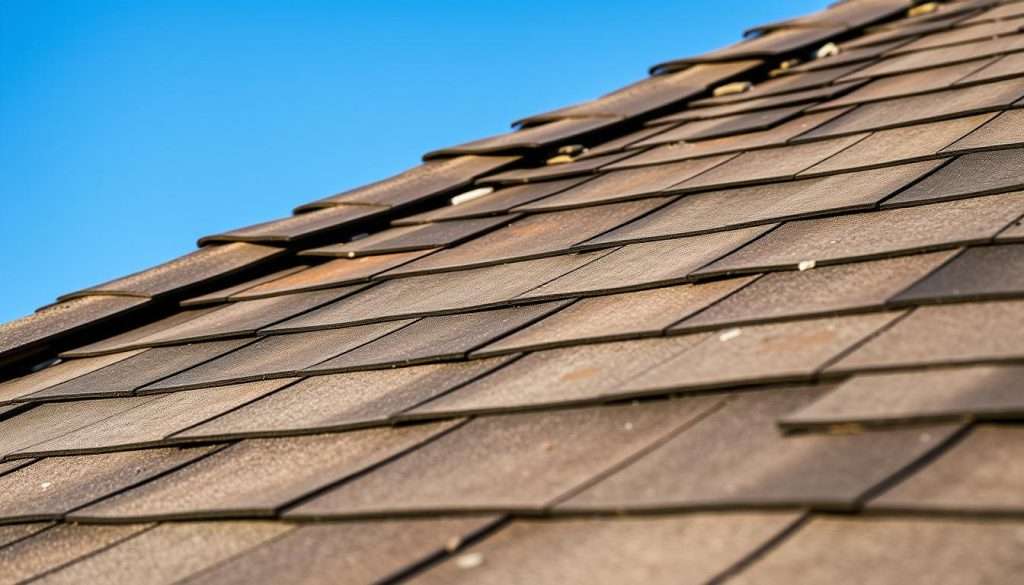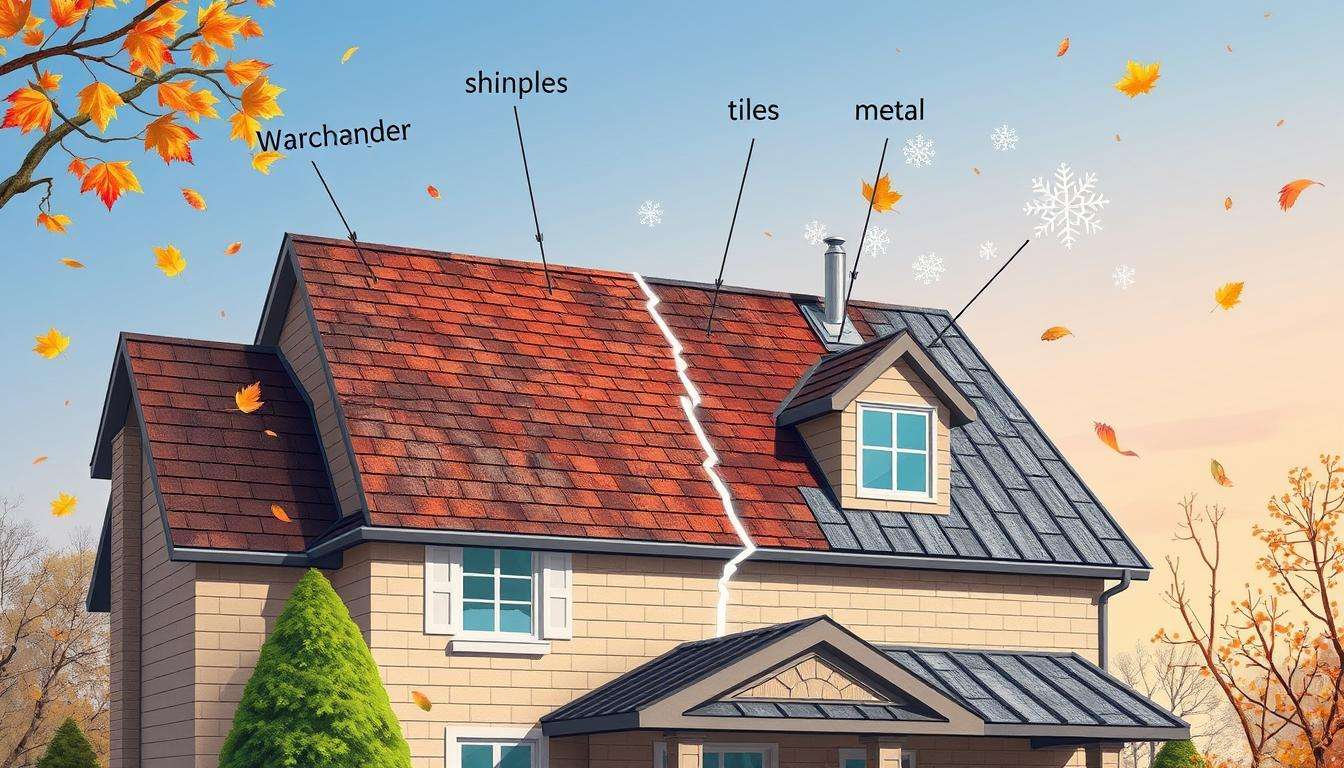Knowing when to replace your roof is key for homeowners. Your roof keeps your home safe and sound. Learning about roof replacement helps avoid expensive fixes later.
This guide will cover roof lifespan, material durability, and maintenance tips. You’ll learn about different materials and when to replace your roof. This ensures your home stays safe and strong.
Understanding Roof Lifespan and Materials
Knowing about your roof’s lifespan and the types of roofing materials is key. It helps you decide when to maintain or replace your roof. Different materials last for different times, which affects how often you’ll need a new roof.
Common Roofing Materials and Their Durability
Asphalt shingles are very popular. They last from 20 to 35 years, with some lasting up to 50 years. Metal roofs are very durable, lasting 40 to 70 years or more.
Slate, clay, or concrete roofs can last 50 to 100 years. Some can even last up to 200 years. Wood shake or shingle roofs last about 30 to 40 years with good care. Keeping your roof in good shape can add 5 to 10 years to its life.
Factors Affecting Roof Lifespan
Many things can affect how long your roof lasts. The quality of materials and how well it’s installed matter a lot. Keeping up with roof maintenance is also key.
Weather can also play a big role. Places with lots of rain, wind, or hail can make roofs wear out faster. Regular checks and maintenance can help spot problems early.
Typical Lifespan by Material Type
| Material | Typical Lifespan |
|---|---|
| Asphalt Shingles | 15-35 years |
| Metal Roofing | 40-70 years |
| Slate, Clay, or Concrete | 50-100 years |
| Wood Shingles/Shakes | 30-40 years |
| Flat Roofs | 20-30 years |
Knowing how long different materials last can help you plan. Keep an eye on your roof’s condition. It’s time for a new roof when you notice problems. For more info, check out this essential guide.

Signs Your Roof Needs Replacement
Knowing when to replace your roof is key to keeping your home safe. Spotting the signs for new roof can prevent expensive fixes. Here are some important signs it might be time for a new roof.
Visible Damage and Wear
Start by looking for visible damage on your roof. You might see:
- Cracked, curling, or missing asphalt shingles
- Excessive granules in gutters, showing wear
- Vegetation growth, which can trap moisture and cause decay
- Sagging or wavy rooflines, suggesting structural problems
- Rot or discoloration on attic decking, pointing to leaks
Seeing these signs means it’s time to talk about roof inspection guidelines. Acting fast can prevent bigger issues later.
Age of your Roof
The age of your roof is a big factor in its condition. Most asphalt shingle roofs need attention or replacement by 25 years. If a new roof was put over old shingles, it might only last about 20 years. Remember these points when checking your roof:
- If your roof is over 10 years old and has loose granules, it might need to be replaced.
- Older roofs that start leaking and are over 15 years old usually need to be replaced.
Watching these signs closely can help keep your home looking good and safe.
After Major Weather Events
Extreme weather can really hurt your roof. After big weather, it’s important to check your roof carefully. Look for:
- Leaks that might form after heavy rain or hail damage
- Bending or sagging rooflines from snow or ice
- Rusted gutters, showing water buildup
- Exposed nails, which mean you might need to fix something
After big weather, quick checks can find hidden damage. Talking to a roofing expert ensures a full check, following roof inspection guidelines.

Maintenance Tips to Extend Roof Life
Keeping your roof in good shape is key to its long life and avoiding expensive fixes. A roof maintenance schedule is very important. Regular checks and care can really help your roof last longer. Simple cleaning and quick fixes are crucial for getting the most out of your roof. Here are some important roof maintenance tips:
Regular Inspections and Repairs
Experts say to do regular inspections twice a year. Do one in spring and one in fall. This helps find small problems early, like cracked shingles or damaged flashing.
Fixing these issues quickly stops leaks, rot, and damage. Following roof inspection guidelines is key. It makes sure you catch everything and fix it on time.
Cleaning and Debris Removal
Cleaning roof surfaces and removing debris is very important. Keeping your roof clean stops moss and algae from growing. This is especially true for asphalt shingle roofs, which can get algae.
Homeowners should also clean gutters twice a year, especially in the fall. This stops water from pooling and causing damage.
Importance of Professional Maintenance
Getting skilled professionals for regular maintenance is very important. They can spot problems that homeowners might miss. They can also do special cleaning, like soft washing, which is safer for your roof.
Investing in expert maintenance makes your roof last longer. It also makes your home more valuable.
| Roof Type | Typical Lifespan | Maintenance Frequency |
|---|---|---|
| Asphalt Shingles | 20-30 years | Regular inspections twice a year |
| Tile and Slate | Up to 100 years | Annual inspections recommended |
| Metal Roofs | 50 years or more | Regular inspections every couple of years |
By following these roof maintenance tips, you make your roof look better and stay safe. Regular checks, proper cleaning, and professional help are the best way to extend your roof’s life.
Cost Considerations When Replacing a Roof
When you think about replacing your roof, knowing the costs is key. The average cost in the U.S. is about $9,117. Prices can go from $5,755 to $12,498. Sometimes, especially with top materials, it can cost up to $46,000.
Things that affect the cost include the roof’s size, the materials you choose, labor, and how hard it is to install.
Budgeting for a New Roof
To budget for a new roof, you need to look at all costs. Materials usually make up 40% of the cost, and labor is about 60%. Budgeting for a new roof should also include removing the old roof, which can cost $1 to $5 per square foot. Don’t forget extra costs like repairs before installation and roof warranties for long-term benefits.
Financing Options for Roof Replacement
Looking into financing can help with the cost of a new roof. You might consider personal loans, home equity lines, or roof financing programs. Each option has its own terms and benefits. Knowing these can help you keep your home in good shape without financial stress.
Long-Term Value vs. Upfront Costs
Choosing a good roof is a long-term investment. People often focus on the initial cost without thinking about the benefits of better materials. Even though high-quality materials like slate or copper cost more upfront, they last longer and need fewer repairs. This makes them a smart choice in the long run.
| Item | Average Cost | Cost Range |
|---|---|---|
| Roof Replacement | $9,117 | $5,755 – $12,498 |
| Materials (40%) | Approx. $3,647 | Varies by material |
| Labor (60%) | Approx. $5,470 | $4.35 – $11 per square foot |
| Roof Removal | $1 – $5 per square foot | N/A |
| Average Roof Repair Cost | $1,064 | $379 – $1,763 |
| Premium Materials | $11,000+ | Up to $50,000 |
Working with Roofing Professionals
Choosing the right contractor for your roof is very important. A good roofer can make your roof last longer and look better. Look for experience, good reviews, and the right licenses and insurance.
The best contractor will do great work and make the project easier for you.
How to Choose the Right Contractor
Start by looking at their experience and what they specialize in. Check their references and online reviews. Good communication and answers to your questions are important.
Questions to Ask Before Hiring
Ask important questions to understand their work. Find out about timelines, past projects, and maintenance needs. Also, ask about warranties to avoid extra costs later.
A good contractor will answer all your questions and make you feel sure about your choice.
Understanding Warranties and Guarantees
Know about the warranties before you hire a roofer. Warranties can cover repairs and last for a long time. A good warranty means your roof is safe and you can relax.
